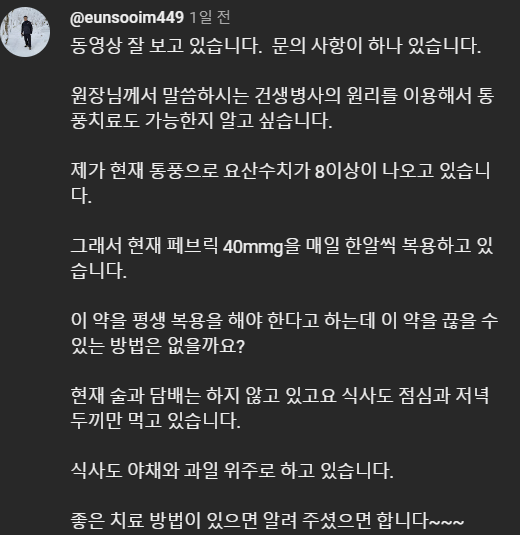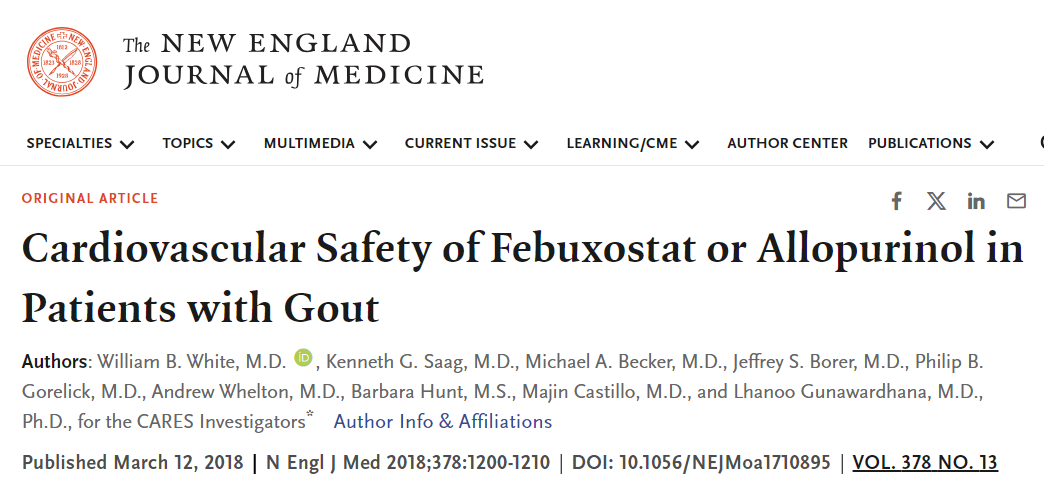
문형철 치유연구소가 오랫동안 가지고 있던 의문
강력한 항산화 효과가 있는 요산 수치를 떨어뜨리는 통풍치료 과연 옳은 것일까?
사례) 요산수치 8 통풍환자
페브릭 40mmg 매일 복용으로 현재 요산수치 5

아래와 같은 위험성에도 과연 페부릭(페북소스타트) 약물을 복용하는 것이 옳을까?
총 6190명의 환자가 무작위 배정되어 페북소스타트 또는 알로퓨리놀을 투여받고 중앙값 32개월(최장 85개월) 동안 추적 관찰을 받았습니다. 56.6%의 환자가 임상시험 요법을 중단했고 45.0%는 추적 관찰을 중단했습니다. 수정된 치료 의도 분석에서 페북소스타트 그룹 335명(10.8%), 알로퓨리놀 그룹 321명(10.4%)에서 1차 평가변수 사건이 발생했습니다

총 6190명의 환자가 무작위 배정되어
페북소스타트 또는 알로퓨리놀을 투여받고
중앙값 32개월(최장 85개월) 동안 추적 관찰을 받았습니다.
56.6%의 환자가 임상시험 요법을 중단했고
45.0%는 추적 관찰을 중단했습니다.
수정된 치료 의도 분석에서
페북소스타트 그룹 335명(10.8%),
알로퓨리놀 그룹 321명(10.4%)에서 1차 평가변수 사건이 발생했습니다(위험비, 1.03; 일측 98.5% 신뢰구간[CI] 상한, 1.23; 비열등성에 대한 P=0.002). 페북소스타트 그룹은 알로퓨리놀 그룹보다 모든 원인에 의한 사망 및 심혈관계 사망률이 더 높았습니다(모든 원인에 의한 사망 위험비, 1.22 [95% CI, 1.01~1.47]; 심혈관계 사망 위험비, 1.34 [95% CI, 1.03~1.73]). 환자가 치료를 받는 동안 발생한 사건에 대한 분석에서 1차 평가변수와 모든 원인 및 심혈관 사망률에 대한 결과는 수정된 치료 의향 분석의 결과와 유사했습니다.
결론
통풍과 주요 심혈관계 질환이 공존하는 환자에서 페북소스타트는 심혈관계 부작용 발생률과 관련하여 알로퓨리놀에 비해 비열등하지 않았습니다. 모든 원인에 의한 사망률과 심혈관계 사망률은 페북소스타트가 알로푸리놀보다 높았습니다. (다케다 개발 센터 아메리카의 자금 지원, CARES 임상시험.gov 번호, NCT01101035).

https://journals.plos.org/plosone/article?id=10.1371/journal.pone.0179426

Abstract
Reactive oxygen species (ROS) are generated spontaneously in all organisms and cause oxidative damage to biomolecules when present in excess. Accumulated oxidative damage accelerates aging; enhanced antioxidant capacity may be a positive factor for longevity. Recently, numerous studies of aging and longevity have been performed using short-lived animals, however, longevity mechanisms remain unknown. Here we show that a termite Reticulitermes speratus that is thought to be long-lived eusocial insect than other solitary insects uses large quantities of uric acid as an antioxidant against ROS. We demonstrated that the accumulation of uric acid considerably increases the free radical-scavenging activity and resistance against ultraviolet-induced oxidative stress in laboratory-maintained termites. In addition, we found that externally administered uric acid aided termite survival under highly oxidative conditions. The present data demonstrates that in addition to nutritional and metabolic roles, uric acid is an essential antioxidant for survival and contributes significantly to longevity. Uric acid also plays important roles in primates but causes gout when present in excess in humans. Further longevity studies of long-lived organisms may provide important breakthroughs with human health applications.
활성산소종(ROS)은
모든 유기체에서 자연적으로 생성되며
과잉 존재할 경우 생체 분자에 산화적 손상을 일으킵니다.
산화 손상이 누적되면
노화가 가속화되며,
항산화 능력이 강화되면
장수에 긍정적인 요인이 될 수 있습니다.
최근 수명이 짧은 동물을 대상으로 노화와 장수에 대한 수많은 연구가 수행되었지만, 장수 메커니즘은 아직 밝혀지지 않았습니다.
본 연구에서는
다른 독신 곤충에 비해 장수하는
유사회성 곤충으로 알려진 흰개미 레티쿨리테르메스 스페라투스(Reticulitermes speratus )가
다량의 요산을 항산화제로 사용하여
ROS에 대항한다는 것을 보여주었습니다.
우리는
요산의 축적이 실험실에서 관리되는 흰개미에서
활성산소 제거 활성과
자외선에 의한 산화 스트레스에 대한 저항력을
상당히 증가시킨다는 사실을 입증했습니다.
또한
외부에서 투여된 요산이
산화도가 높은 조건에서 흰개미의 생존을 돕는다는
사실도 발견했습니다.
이 데이터는
요산이
영양 및 대사 역할 외에도 생존에 필수적인 항산화제이며
장수에 크게 기여한다는 것을 보여줍니다.
요산은
영장류에서도 중요한 역할을 하지만
인간에게 과도하게 존재하면 통풍을 유발합니다.
장수 생물에 대한 추가 장수 연구는
인간 건강에 중요한 돌파구를 제공할 수 있습니다.
Introduction
Numerous studies of longevity and lifespan extension have been performed using various organisms, including yeast, fruit fly, nematodes, and mice, and various metabolic pathways and molecules have been implicated in life span extension [1]. In particular, growth hormone, insulin, insulin like growth factor-1, and target of rapamycin pathways have been actively investigated, and sirtuin genes have been identified as ‘longevity genes’ that are upregulated in animals whose lives have been prolonged by caloric restriction [2]. Sirtuins are NAD+-dependent protein deacetylases that regulate various downstream molecules and are highly conserved from yeast to human [3]. In addition to life span-extension using caloric restriction, long-lived organisms have been generated by genetic engineering [4].
Yeast, fruit fly, nematodes, and mice are ideal models for studying the mechanisms of longevity, with relatively short lifespan and short gestation times. However, novel animal models have recently been made applicable for longevity studies following the development of techniques, such as new generation sequencing analysis. Among these, the naked mole rat Heterocephalus glaber and the blind mole rats Spalax sp. and Nannospalax sp. are subterranean eusocial rodents with extraordinarily long lifespans and resistance to tumorigenesis [5]. Although several studies of these animals are underway, the core mechanisms of longevity remain unidentified. Various eusocial insects are long-lived and reproductive and non-reproductive individuals contribute distinct services to colonies of ants, bees, wasps, and termites. In particular, the lifespans of reproductive and non-reproductive termites differ by 10–100 fold, although the longevity of non-reproductive termites is much longer than that of common solitary insects [6–8]. Although extensions of life span have been of interest for a long time, the mechanisms that contribute to longevity remain unknown.
In this study, we investigated the contribution of oxidative defences to the longevity of termites. Specifically, reactive oxygen species (ROS) are generated spontaneously during normal metabolic activities, and excessive ROS generation causes damage to biomolecules, such as DNA, proteins, and lipids. Accordingly, accumulated oxidative damage has been shown to reduce lifespan in mice, insects, yeast, and nematodes, whereas enhanced antioxidant capacity contributes to longevity [9,10]. In addition, immotile plants have various antioxidants such as ascorbic acid and flavonoids that protect against strong oxidative stress in harsh environments. In the present study, we hypothesised that long-lived termites have strong oxidative defence mechanisms and showed that the common Japanese termite R. speratus produces large quantities of the strong antioxidant uric acid, which contributes to longevity.
효모, 초파리, 선충, 생쥐 등 다양한 생물을 이용하여
장수 및 수명 연장에 대한 수많은 연구가 수행되어 왔으며, 다
양한 대사 경로와 분자가 수명 연장에 관여하는 것으로 밝혀졌습니다 [1].
특히
성장호르몬,
인슐린,
인슐린 유사 성장인자-1,
라파마이신 타겟 경로 등이 활발히 연구되고 있으며,
칼로리 제한으로 수명이 연장된 동물에서
시르투인 유전자가 상향 조절되는
'장수 유전자'로 확인되었습니다 [2].
시르투인은
다양한 하류 분자를 조절하는 NAD+ 의존성 단백질 탈아세틸화 효소이며
효모에서 인간에 이르기까지 고도로 보존되어 있습니다[3].
칼로리 제한을 통한 수명 연장 외에도
유전 공학을 통해 장수 생명체가 만들어지고 있습니다[4].
효모, 초파리, 선충, 생쥐는
상대적으로 수명이 짧고
임신 기간이 짧아 장수의 메커니즘을 연구하기에 이상적인 모델입니다.
하지만 최근 차세대 염기서열 분석 등의 기술이 발전하면서 새로운 동물 모델들이 장수 연구에 활용되고 있습니다. 이 중 벌거벗은 두더지 쥐 헤테로세팔루스 글라버(Heterocephalus glaber )와 맹인 두더지 쥐 스파락스(Spalax sp.)와 난노스팔락스(Nannospalax sp.)는 수명이 매우 길고 종양 발생에 저항성이 있는 지중 유사회 설치류입니다[5].
이 동물들에 대한 여러 연구가 진행 중이지만 장수의 핵심 메커니즘은 아직 밝혀지지 않았습니다.
다양한 유사회성 곤충은
수명이 길고 번식력이 있는 개체와
그렇지 않은 개체가 개미, 벌, 말벌, 흰개미 등의 군집에 뚜렷한 기여를 하고 있습니다.
특히,
번식성 흰개미와 비번식성 흰개미의 수명은
10~100배 정도 차이가 나지만,
비번식성 흰개미의 수명은
일반적인 독방 곤충의 수명보다 훨씬 길다[6-8].
수명의 연장은 오랫동안 관심의 대상이 되어 왔지만, 수명에 기여하는 메커니즘은 아직 밝혀지지 않았습니다.
이 연구에서는
흰개미의 수명에 대한 산화 방어의 기여도를 조사했습니다.
특히
활성산소종(ROS)은
정상적인 대사 활동 중 자연적으로 생성되며,
과도한 ROS 생성은
DNA, 단백질, 지질 등 생체 분자에 손상을 일으킨다.
따라서
생쥐, 곤충, 효모, 선충 등에서 산화적 손상이 축적되면
수명이 단축되는 반면,
항산화 능력이 강화되면
또한
부동성 식물(immotile plants)은
아스코르브산, 플라보노이드와 같은 다양한 항산화 물질을 가지고 있어
열악한 환경에서 강한 산화 스트레스로부터 보호합니다.
본 연구에서는
장수 흰개미가 강력한 산화 방어 메커니즘을 가지고 있다는 가설을 세우고
일본 흰개미 R. 스페라투스가 강력한 항산화제인 요산을 다량 생산하여
장수에 기여한다는 것을 보여주었습니다.
